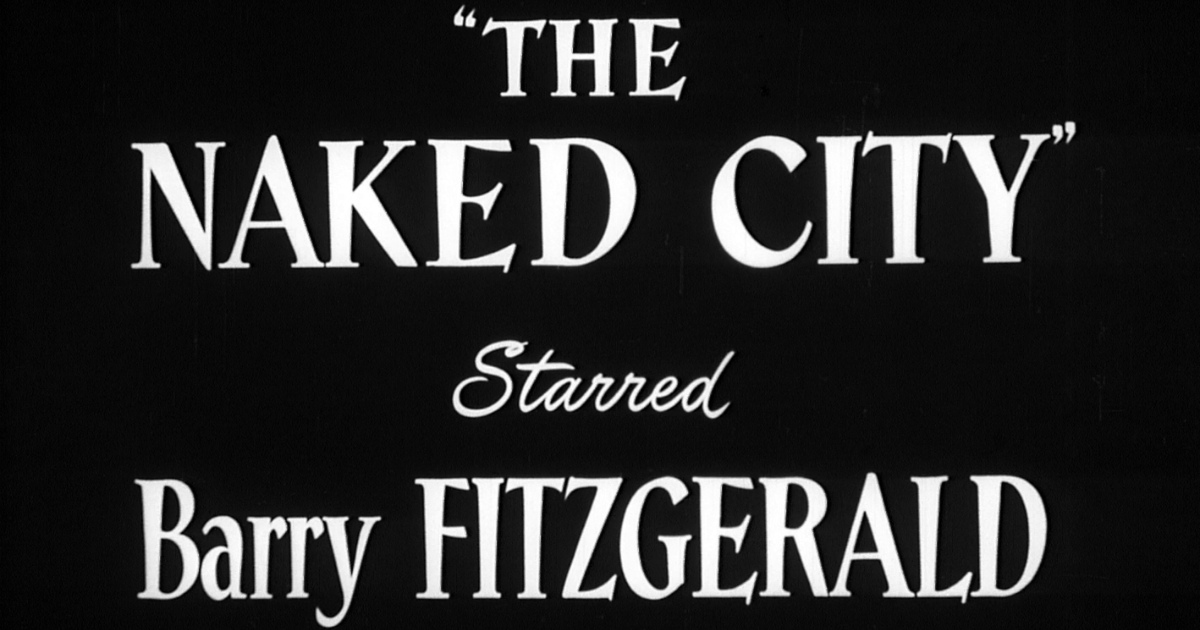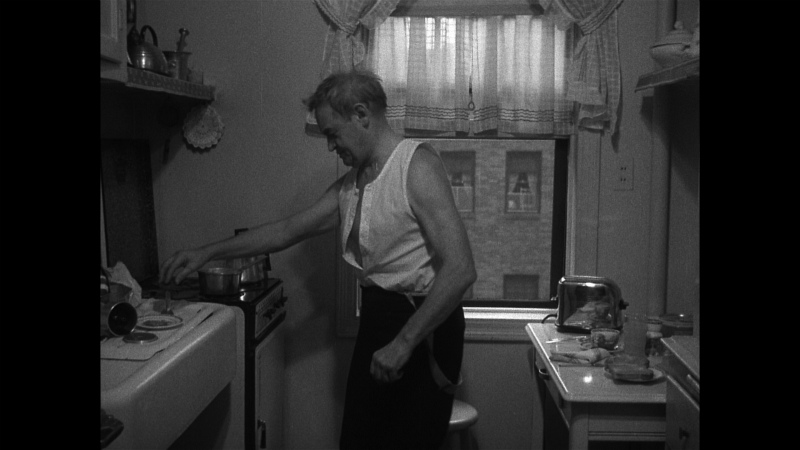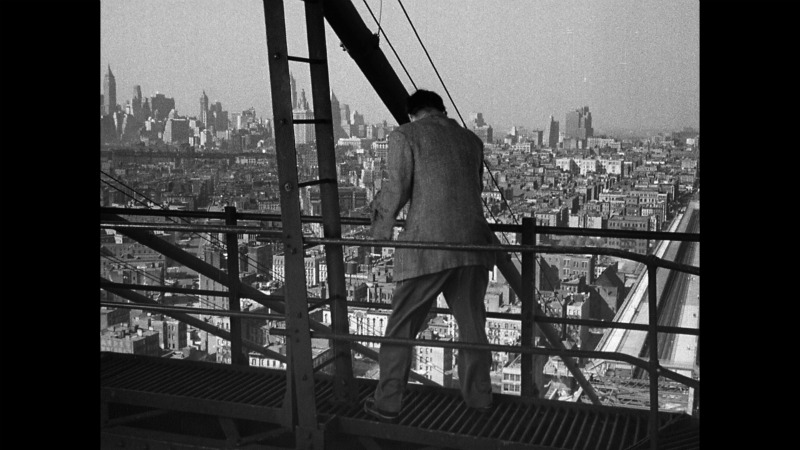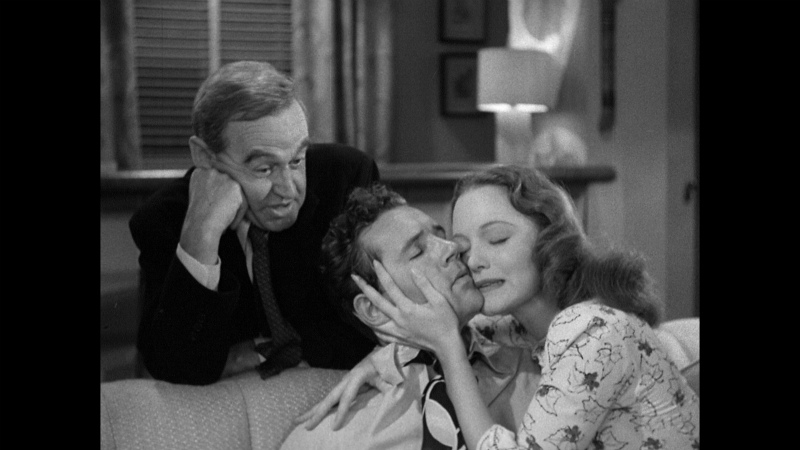
The film industry’s relationship with “reality” has been a tenuous one from the start. Though the earliest years of the form were rife with very short films depicting everyday life, from the moment it became a real business, everyday life was alternately exploited, exaggerated, or ignored. The silent comedies and epics of the 1910s mixed studio work with tons of location shooting; many of Mack Sennett’s more outlandish comedies were shot on real locations. The Birth of a Nation utilized scores of real locations to recreate battle scenes for a story that outright mocked history. Early film audiences were not at all unaccustomed to the juxtaposition of reality and invention.
Yet by 1948, after two decades in which Hollywood – needing to control shooting conditions more and more after the advent of sound – could construct nearly anything in a studio lot, to have a picture come out that took (almost) entirely to the streets of New York for its production must have seemed like a revolution. So much so that The Naked City can almost get away with its pronouncement that it is merely depicting the actual process that police departments undertake in investigating a crime. Almost. What becomes interesting, then, is the tension between the film’s documentary-esque claims and its more traditional dramatic presentation.

The construction starts with the nature of the case itself – a party girl is found murdered, and her associations stretch from the Lower East Side to Park Avenue, with all the highs and lows in between. In the commentary track on this release, screenwriter Malvin Wald says he found the story in the actual New York police files, changing a few details to make the pieces fit together a little bit more neatly. As the lead detective, Dan Muldoon (Barry Fitzgerald), frequently says, it is a “heavy case,” full of several tangents on the road to finding the killer (who is, contrary the the film’s otherwise working-class ethos, the poorest suspect), including the investigation of a series of thefts.
The film does give quite a lot of credence to the value of the extensive, laborious work the police have to do at every turn – a lot of time spent just showing pictures to people, hoping they’ll recognize somebody – tapping into not just the physical wear that work causes, but also the exponential joy when it actually pays off. It’s one thing for a Philip Marlowe type to land on just the right clue to confirm the suspicion he had all along. The Naked City very nicely illustrates how little the police have to go on with an average murder, and how any number of elements could be the one the resolve it. Everyone they interview, no matter how innocent they seem, gets followed, and interviewed again, and investigated, and so on. Every item in the room in which the body is found must be carefully inspected. There are no small clues, and everything that seems obvious may turn out to be a complete misdirect. It doesn’t have many of the same thrills that define Jules Dassin’s other films (which include Brute Force, Night and the City, and Rififi), but he brings the same sort of momentum to the subject matter here.

All of this becomes an excuse to cover as much of the city as possible, the most ridiculous instance being a visit to a construction site to speak with the killer’s brother. The brother could work just about anywhere, but where better to film such a shoot than a construction site? You really can see the whole city from here.
It doesn’t all quite cohere dramatically. One gets the sense of feeling torn from place to place, never mind from emotion to emotion. One minute, the girl’s parents are there identifying the body; the next, the junior detective (Jimmy Halloran) is playfully debating with his wife whose responsibility it is to beat their child. But in taking such an ambitious approach, by trying to get as many points of view in as possible (in addition to those directly involved in the case, the film also includes shots of assorted, disconnected people, with accompanying voiceover expressing their thoughts), it really cements the film’s final, iconic line – “There are eight million stories in the naked city. This has been one of them.” During the killer’s big getaway scene, he brags to Halloran that once he’s out of there, they’ll never find him. The city’s too big, he says, and there are too many places to hide. After ninety minutes traversing every corner of the place, we’re inclined to believe him.

Arrow Films’s new Blu-ray edition of The Naked City doesn’t provide the cleanest transfer you’re likely to see, but then, for a film attempting to get down in the muck of it all, would the value of that be so great? Clarity, depth, and contrast are all nicely managed; they’re just working from a beat-up source, and there’s only so much you can do with a thing like that. So it has some scratches, some specks, and a jump or two as they cut from shot to shot, but overall, nothing really distracting or unfamiliar to fans of older films, especially if you’re accustomed to seeing them on a print. What’s really outstanding, and what makes the most difference when you’re dealing with a film that emphasizes the physicality of a place, is the depth. Getting to see all the way down a city street, or even just the detail on storefronts, alleys, and offices makes all the difference to appreciating what they set out to accomplish here.
Arrow’s put together a nice selection of supplements, starting with Malvin Wald’s commentary track, also available in Criterion’s 2007 DVD edition of the film. I thought for awhile that it might have been recorded much earlier, as his sole points of modern reference are rooted in the early-to-mid-90s (Pulp Fiction, the O.J. Simpson case, NYPD Blue), but, hey, the guy was around ninety as we’re hearing him, so that’s all right with me. He has a pretty sharp recollection of it all, and certainly isn’t shy about his own accomplishments, citing many times the Academy Award nomination he received for it. He sometimes slips into simply narrating the onscreen action, but overall, this is a much more interesting, lively track than a lot of creators half his age give. I thoroughly enjoyed listening to it.
Also ported over from the Criterion disc is a 40-minute conversation with Dassin at LACMA in 2004, following a screening of Rififi. Naturally, the conversation focuses more on that film than The Naked City, but if you’re at all a fan of Dassin (and really, why wouldn’t you be), this is a gold mine. He certainly had a lively career, escaping the Europe in the 1950s after he was blacklisted from Hollywood, but seems more bemused, at this point, by the shape of his career than angry about it.

Left back on the Criterion edition are an interview with Dana Polan and an analysis of the film’s shooting locations by James Sanders, but what we gain isn’t too shabby – a gallery of production stills by photojournalist Weegee, whose famous crime photography heavily influenced the film; a 1950 documentary short on the famous Hollywood Ten, who refused to name name to the House of Un-American Activities (including The Naked City‘s co-screenwriter, Albert Maltz); and best of all, a forty-minute video piece with film critic Amy Taubin, discussing the history of New York onscreen. She delves into some fascinating corners, rarely highlighting the most famous examples of New York shoots, choosing instead to highlight experimental filmmakers in the 1960s and, for her sole 21st century entry, the very recent film Heaven Knows What. It’s a really exceptional, truly educational look at the subject.
The booklet includes an essay by film scholar Alastair Phillips, who gives a very fine overview of the film’s production, and the considerable contributions of the creative team. There seems to be some debate amongst various participants as to who originated the project – producer Mark Hellinger undoubtedly had a huge hand, but Wald takes credit for much of what Phillips assigns to Hellinger – but whatever the case, this was more than a classic case of auteurism, and it took several cooks to put this together. The booklet also collects snippets from (overwhelmingly positive) contemporary reviews; a short biography of cinematographer William H. Daniels by filmmaking teacher Barry Salt, who ties Daniels’s start as a camera assistant on the set of Erich von Stroheim films to his eventual work in The Naked City; and an overview of the popular TV series adapted from the film.
All in all, another stellar package from Arrow Films. The Naked City is pretty far from my favorite Dassin film, but it nonetheless offers him a chance to exploit the city’s natural landscape for his expressive purposes, culminating in a chase scene that’s as exciting as anything he’s ever done. I enjoyed revisiting this film more than I expected, its sardonic wit (courtesy of the narrator, producer Mark Hellinger) emerging as a key characteristic in what earlier felt too heavy on the procedural angle. The transfer and supplements do the film tremendous justice.



![Bergman Island (The Criterion Collection) [Blu-ray]](https://criterioncast.com/wp-content/uploads/2022/11/bergman-island-the-criterion-collection-blu-ray-400x496.jpg)
![This Is Not a Burial, It’s a Resurrection (The Criterion Collection) [Blu-ray]](https://criterioncast.com/wp-content/uploads/2022/11/this-is-not-a-burial-its-a-resurrection-the-criterion-collection-blu-ray-400x496.jpg)
![Lars von Trier's Europe Trilogy (The Criterion Collection) [The Element of Crime/Epidemic/Europa] [Blu-ray]](https://criterioncast.com/wp-content/uploads/2022/11/lars-von-triers-europe-trilogy-the-criterion-collection-the-element-of-400x496.jpg)
![Imitation of Life (The Criterion Collection) [Blu-ray]](https://criterioncast.com/wp-content/uploads/2022/11/imitation-of-life-the-criterion-collection-blu-ray-400x496.jpg)
![The Adventures of Baron Munchausen (The Criterion Collection) [4K UHD]](https://criterioncast.com/wp-content/uploads/2022/11/the-adventures-of-baron-munchausen-the-criterion-collection-4k-uhd-400x496.jpg)
![Cooley High [Criterion Collection] [Blu-ray] [1975]](https://criterioncast.com/wp-content/uploads/2022/11/cooley-high-criterion-collection-blu-ray-1975-400x496.jpg)